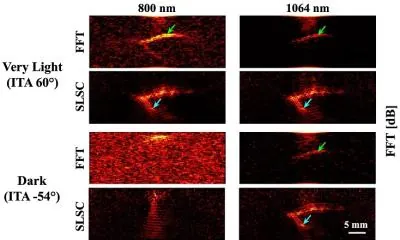
Breakthrough Breast Imaging Method Addresses Skin Tone Bias, Revolutionizing Cancer Detection
2024-11-18
Author: Daniel
Introduction
In an exciting development for breast cancer diagnosis, researchers at Johns Hopkins University are pioneering a new imaging technique that may significantly enhance visibility across various skin tones. While traditional imaging methods such as mammography have long been the standard, they often fall short, particularly for women with dense breast tissue. Enter photoacoustic imaging—a cutting-edge approach that merges light and sound to create intricate images of breast tissue.
The Issue of Skin Tone Bias
However, a recent study has unveiled a serious issue: skin tone bias within these imaging technologies. Published in *Biophotonics Discovery*, this research explored how variations in skin tone can affect the detection of breast cancer targets utilizing three different image reconstruction methods: fast Fourier transform (FFT), delay-and-sum (DAS) beamforming, and short-lag spatial coherence (SLSC) beamforming.
Research Findings
The researchers conducted simulations using different wavelengths (757, 800, and 1064 nm), target sizes ranging from 0.5 to 3 mm, and skin tones varying from very light to dark. The findings were eye-opening. Traditional methods like FFT and DAS struggled to detect smaller cancer targets under darker skin tones, particularly at the lower wavelengths. Targets smaller than 3 mm were particularly elusive, presenting lower signal-to-noise ratios (SNR) and contrast-to-noise ratios (gCNR). However, the results showed that the 1064 nm wavelength, when paired with SLSC beamforming, dramatically improved visibility for targets across all skin tones. This combination provided clearer images with enhanced SNR and gCNR values.
Expert Insights
“This work was motivated by a previously poor understanding of photoacoustic imaging performance under combined variations of small target sizes and darker skin tones,” remarked Muyinatu Bell, the study's senior and corresponding author. “Our results are enlightening, as we now have a better understanding of advanced photoacoustic imaging techniques and the wavelengths necessary to accurately detect these small targets.”
Implications for Healthcare
The implications of this research are profound. By addressing the skin tone bias in photoacoustic imaging, the technique could transform the way breast cancer is detected, paving the way for more equitable healthcare for women of all backgrounds. This breakthrough emphasizes the critical importance of factoring in skin tone when developing next-generation imaging systems, ensuring that all women receive high-quality care regardless of their skin color.
Conclusion
As the healthcare community moves towards more inclusive solutions, the future looks promising for early detection and diagnosis of breast cancer through innovative imaging technologies. The hope is that advancements like these will soon become the new standard, reducing disparities in cancer detection and improving outcomes for women everywhere.
Stay Tuned!
Stay tuned as developments unfold in this crucial area of women's health!


 Brasil (PT)
Brasil (PT)
 Canada (EN)
Canada (EN)
 Chile (ES)
Chile (ES)
 Česko (CS)
Česko (CS)
 대한민국 (KO)
대한민국 (KO)
 España (ES)
España (ES)
 France (FR)
France (FR)
 Hong Kong (EN)
Hong Kong (EN)
 Italia (IT)
Italia (IT)
 日本 (JA)
日本 (JA)
 Magyarország (HU)
Magyarország (HU)
 Norge (NO)
Norge (NO)
 Polska (PL)
Polska (PL)
 Schweiz (DE)
Schweiz (DE)
 Singapore (EN)
Singapore (EN)
 Sverige (SV)
Sverige (SV)
 Suomi (FI)
Suomi (FI)
 Türkiye (TR)
Türkiye (TR)
 الإمارات العربية المتحدة (AR)
الإمارات العربية المتحدة (AR)